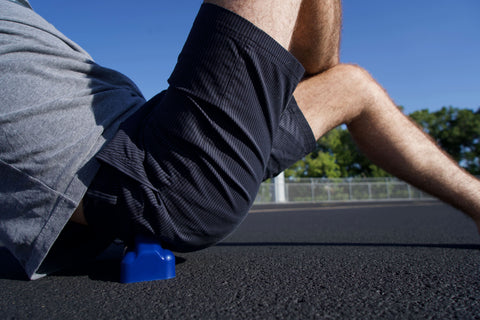Introducing the TWO deep Glute muscles that contribute to a host of low back and tailbone issues: Piriformis and Gluteus Medius.
Piriformis Glute Release
Piriformis can tighten up from high-impact sports with lateral movement, as well as from prolonged sitting. When tight, it can cause buttock pain, duck feet (toes pointed outward by externally rotating the hip) as well as sciatica (by compressing the sciatic nerve - how to relieve sciatica pain while sitting).

Piriformis Placement (above)
Gluteus Medius Glute Release
Gluteus Medius release goes hand in hand with QL release. Massage Glute Medius if you have pain from "overdoing it" (spending a day moving houses, doing yard work, playing hours of basketball, etc.). One sign of a hyperactive Glute Medius is a flattened lower back - the loss of the natural lumbar curve.

Glute Medius Placement (above)
Targets: Gluteus Medius and Piriformis
Check out the anatomical considerations here: Deep Gluteal Muscles
Piriformis & Gluteus Medius Release - Written Instructions

Gluteus Medius Placement: Place the trigger at the top of the glute (right on your waistline) about 3 inches from your side. This location is commonly described as the pocket of the hip or the highest part of your butt that still has meat.
Piriformis Placement: The Piriformis connects the Sacrum (tailbone) to the top of the femur (hip bone) - begin with this picture in mind. Lay on your side and place your pinky finger on your tailbone and thumb on the hip bone (this may be a stretch for your hand). The Piriformis lies in line with these two digits. Watch the comedian Sinbad talk about the perils of the Piriformis here
*images below are for a right Gluteus Medius release*
Level 1: "The Chicken Wing"

Adjust the trigger to feel, trying to individually target the Piriformis and Gluteus Medius. Spend time on tight, sensitive spots - these are trigger points (see the bottom of the page for how to know when you've released a trigger point). Keep in mind that the strike zone for a Gluteus Medius release is large, and can have multiple trigger points. Move the right knee up and down for an active massage.
Level 2: "The Figure Four"

The Figure Four adds a light Gluteus Medius stretch into the equation. This allows more muscle fibers to be accessed with the Claw, which leads to more muscle loosened -> happier glutes and low back.
Level 3: "The Pretzel"

This level is cruel. No glute muscle deserves the Pretzel (especially not poor Gluteus Minimus, it's just a little guy), but here we are giving it to them. From Level 2, elevate your entire back off the ground and rest your upper body weight on the elbows. This is a great deal of pressure on the Gluteus Medius or Piriformis, so work up to this with caution. If you can't physically relax, your muscles will stay tense and will not loosen, so do not attempt this unless you can maintain composure and slow breath.
How to know you've released a trigger point: When you release a knot/trigger point, you will feel the muscle give and will simultaneously feel the device sink into your body. A massage generally feels less painful under higher pressure once a trigger point is released.
Glute Release FAQ:
How To Release Glute Muscles
Massage the glute muscles of choice (Gluteus Medius, Piriformis, and Gluteus Maximus) with a massage tool. Afterward, stretch the glute muscles for additional muscle release.
How To Release Outer Glute Muscles
See Gluteus Medius release (the largest outer glute muscle) to release the outer glute muscle.
Lacrosse Ball Glute Release
A tennis, lacrosse, or massage ball can also be used for glute release. Regardless of your tool, make sure to thoroughly massage the glute muscles for optimal release.
Sources/Influences:
[1] Donnelly, Joseph M. Travell, Simons & Simons Myofascial Pain and Dysfunction: the Trigger Point Manual. 3rd ed., Wolters Kluwer Health, 2019.
[2] Davies, Clair, and Amber Davies. The Trigger Point Therapy Workbook: Your Self-Treatment Guide for Pain Relief. 3rd ed., New Harbinger Publications, Inc., 2013.


